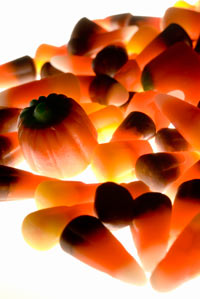As Halloween approaches, a food scientist muses on the coming ‘candy season’

Photo: Jeff Miller
In anticipation of the candy season — those sugar-packed months stretching from Halloween through Easter, marked by a succession of candy corn, chocolate turkeys, ribbon candy, candy hearts and chocolate eggs — UW–Madison food scientist Rich Hartel answers some questions about candy and the candy business.
Hartel has co-authored textbooks on ice cream and candy-making and helps teach the annual Resident Course in Confectionary Technology held every summer at UW–Madison. Candy companies big and small across the nation employ his former students.
Hartel will give a talk at the Wednesday, Oct. 31, "Wednesday Night @ the Lab" series titled "The Science of Halloween Candy: The Tricks in Making the Treats." The talk, sponsored by the UW–Madison Science Alliance, will be held from 7-8:15 p.m. in Room 1360 Biotechnology Center, 425 Henry Mall.
What are some trends in the candy business?
One is trying to make candy somewhat healthier — adding calcium to fudge, or making sure dark chocolate has antioxidants. Another one is the trend to high-end candies, such as expensive truffles. Organic chocolate is definitely a big deal these days.
Is there a surge in the boutique candy business?
Yes. I think it’s because in general people are being more careful about what they eat, but when they want a treat now, they want it to be really good.
Is candy a big business in Wisconsin?
It’s not huge, but there are a number of companies that make candy or candy ingredients. There are a few companies in Milwaukee, such as the old Ambrosia chocolate company (now ADM Cocoa) and Buddy Squirrel. Melster Candy Company in Cambridge is the leading producer of circus peanuts. Locally, Clasen Quality Coatings in Middleton (with a new plant in Watertown) is growing rapidly. Chicago has long been known as the hub of the candy industry.
How far ahead of Halloween do they make candy?
Sometimes as far ahead as six months. Many candy companies are now into their Easter season of products.
Is trick-or-treating going out of style? Do candy-makers worry about this?
Maybe a little. People are more cautious about letting their kids out on the streets, although there are still lots of local communities where the kids still get out. The general sense that candy is part of the obesity problem is also causing a slow-down, what with many schools now banning sweet treats from school functions. In general, the candy industry isn’t seeing much growth.
When is it time to pitch the trick-or-treat bag leftovers?
Some candy is good for more than a year while other candy goes bad in two to three months. It depends mostly on the nature of the candy and is usually related to how fast moisture migration occurs. Most candy gets hard over time as it dries out, although hard candy is the reverse — it gets sticky when it picks up moisture.
Is candy-making seasonal? Is Halloween the biggest time?
Some companies, such as Mars and Nestle, have products that cross holidays, while others, such as Just Born, which manufactures Peeps, are more focused. But even the holiday-focused companies try to put out products that cross seasons — such as Halloween and Christmas Peeps.
What’s a memorable candy fad?
A 1960s product called Fizzies was a tablet that you added to water to produce a sweet, bubbly drink. The tablet was too small to hold enough sugar to sweeten the drink, so it was sweetened with cyclamates, which are 30 times sweeter than sugar. Fizzies were taken off the market when the government labeled cyclamates as carcinogenic. That was later found not to be true, but by then Fizzies was out of business. But now they’re back — formulated with different sweeteners.
What are some of the unusual candies now being marketed?
I think Pop Rocks-type candies are pretty neat — they are active in your mouth and the process for making them is cool. A company in Wisconsin — Raven Manufacturing of Wrightstown — is making this type of candy under the name of Exploding Pops. The real sour candies are something else, too. And the candies that change color in your mouth — even painting the mouth different colors — are interesting, too.
Tags: food science




